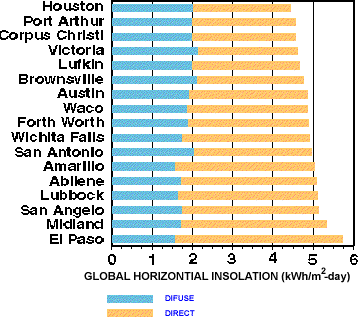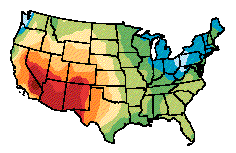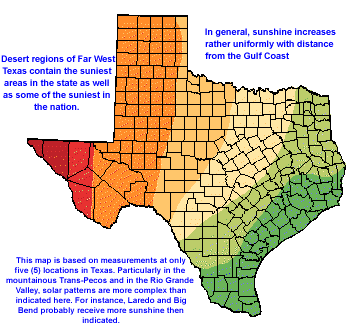|
Solar energy is the most democratic of renewable energy resources.
It is available everywhere on the earth in quantities that vary only
modestly. Variations that do occur stem from cloud cover patterns and
other lesser influences, including elevation and the prevalence of
airborne gases and particles such as humidity, pollution, and dust.
Solar radiation that avoids atmospheric scattering and arrives at the
earth's surface in an unbroken line from the sun is termed direct,
while the scattered radiation that reaches the earth from all parts
of the sky is called diffuse. The distinction is important because
diffuse radiation cannot be effectively focused; only direct
radiation is relevant to the solar technologies that use mirrors and
lenses to concentrate the sun's rays. The combined contributions of
direct and diffuse result in the total, or global radiation, the
quantity of interest for non-concentrating solar technologies such as
rooftop solar panels.
Like most of the U.S., the various solar properties have been
measured at only a small number of locations in Texas. Information
from these limited measurements, coupled with estimates based on
weather data and satellite images, provides the basis for the design
of solar installations such as rooftop solar water and space heating
systems, photovoltaic panels (electricity generated directly from
solar cells), solar detoxification devices and large solar electric
power plants. Solar radiation information is also important for
building design and improved management of agriculture.
Insolation is the total amount of solar radiation that strikes a
particular location over a given period of time, typically a single
day. Horizontal insolation is the amount received by a horizontal
surface such as a lake, field, or office building rooftop. Figure 3
depicts the average daily horizontal insolation for a number of Texas
cities. The chart partitions the global insolation (blue plus orange)
into its direct (orange) and diffuse (blue) components. The diffuse
data, important for daylighting applications, indicate that a
skylight in East Texas will provide more useful light than a
comparable one located in West Texas. Across the state, global
horizontal insolation averages about 5 kWh/m2-day and varies by only
25% from Houston to El Paso. This is significant, as many people
assume that only West Texas has the good sunshine necessary to use
solar energy; in reality, fixed surface technologies can find
application throughout the state.
Solar equipment is frequently installed on structures that are at
some angle to the ground. The radiation on such a fixed, tilted
surface will be more or less than on a horizontal one depending on
the angle of tilt and orientation. A pitched, south-facing roof, for
example, will generally receive about 10 to 15% more energy than
suggested by Figure 3. Based on these levels of insolation, the
average Texas family would need to cover about half of their roof
with 10% efficient photovoltaic panels to generate as much
electricity as they use. Or similarly, the majority of the family's
hot water needs could be met with only a few large solar water
heating panels. Many of these small-scale, fixed surface solar
technologies intended for residential and "off-grid" use are already
common in Texas. These systems, some of which can be directly
integrated into buildings, often provide added value to the owner or
embody unique characteristics that make them the most cost-effective
option available.
 FIGURE 3. Global Horizontal
Insolation for Texas Cities.
FIGURE 3. Global Horizontal
Insolation for Texas Cities.
Throughout Texas, sunshine is adequate to power rooftop
systems such as photovoltaic or water heating systems.
The National Renewable Energy Laboratory (NREL) has developed
estimates for solar radiation to complement the small number of solar
measurements that are available. Figures 4 and 5, developed by NREL,
show the average direct normal insolation in the conterminous United
States and in Texas. Normal insolation refers to the amount that
strikes a surface that always faces the sun. West Texas exhibits the
highest levels of direct normal insolation in Texas as well as some
of the highest levels in the entire nation. Compared to East Texas,
West Texas experiences 75% more direct solar radiation.
Direct normal insolation is the quantity of interest for
concentrating technologies that track the sun throughout the day and
intensify natural sunlight to yield very high temperatures or
generate electricity efficiently. Since wholesale energy markets are
dictated almost solely on price, solar power plants trying to compete
in this arena will need to be located in regions with very good
direct radiation. To support prospective developments of this type,
improved solar radiation data are needed throughout the Trans-Pecos
and along the Rio Grande.
Solar radiation is available throughout the state in sufficient
quantity to power distributed solar systems such as solar water
heaters and off-grid photovolatic panels. On the other hand, large
solar power plants will almost certainly be most cost-effective when
sited in areas of West Texas that receive very high levels of direct
solar radiation. Solar developments of both types can become major
contributors to satisfying the future energy needs of Texas.
| AVERAGE DIRECT NORMAL INSOLATION |
| COLOR |
per day |
per YEAR |
| KEY |
(kWh/m2-day) |
(MJ/m2) |
(quads/100 mi2) |
 |
<3.0 |
<3,940 |
<1.0 |
 |
3.0 - 3.5 |
3,940 - 4,600 |
1.0 - 1.1 |
 |
3.5 - 4.0 |
4,600 - 5,260 |
1.1 - 1.3 |
 |
4.0 - 4.5 |
5,260 - 5,910 |
1.3 - 1.5 |
 |
4.5 - 5.0 |
5,910 - 6,570 |
1.5 - 1.6 |
 |
5.0 - 5.5 |
6,570 - 7,230 |
1.6 - 1.8 |
 |
5.5 - 6.0 |
7,230 - 7,880 |
1.8 - 1.9 |
 |
6.0 - 6.5 |
7,880 - 8,540 |
1.9 - 2.1 |
 |
6.5 - 7.0 |
8,540 - 9,200 |
2.1 - 2.3 |
 |
>7.0 |
>9,200 |
>2.3 |

FIGURE 4. U.S. Direct Normal Insolation. (see legend above)

FIGURE 5. Texas Direct Normal Insolation.
This quantity is relevant to concentrating solar equipment
that usesmirrors or lenses that track the sun throughout the day.
|



